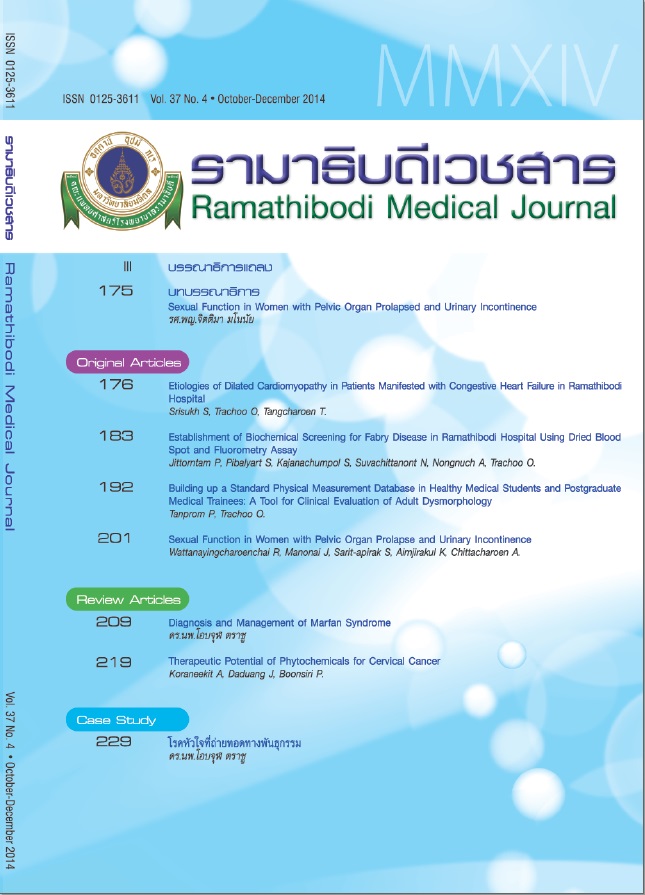Establishment of Biochemical Screening for Fabry Disease in Ramathibodi Hospital Using Dried Blood Spot and Fluorometry Assay
Main Article Content
Abstract
Background: Fabry disease (FD) is an X-linked lysosomal storage disorder caused by a deficiency of Alpha-galactosidase A (a-GAL A). This enzyme defect results in the accumulation of glycolipid in various organs such as kidney, heart and brain. Therefore, screening of Fabry disease is recommended in patients with unexplained causes of chronic kidney disease, left ventricular hypertrophy and stroke.
Objective: To develop the use of a-GAL A assay for future Fabry disease screening.
Methods: a-GAL A screening using fluorometry was performed in dried blood spot (DBS). The standardization was done using quality-control DBS pools provided by the CDC, USA. Validation of the assay was performed in 118 unrelated normal control subjects.
Results: The standardization of the assay was not different from the QC-DBS references. Validation of the assay in normal control subjects revealed no difference of a-GAL A activity between mates and females. The values at the 3rd centile was proposed for the use as cut-off points for Fabry disease screening in the Thai population, approximately 2.9 nmol/mL/hr.
Conclusions: a-GAL A assay using DBS-fluorometry was successfully developed in Ramathibodi Hospital. The establishment of biochemical testing for Fabry disease is expected to benefit the clinical service in the near future.
Article Details
References
Eng CM, Germain DP, Banikazemi M, et al. Fabry disease: guidelines for the evaluation and management of multi-organ system involvement. Genet Med. 2006;8(9):539-548.
Brady RO, Gal AE, Bradley RM, et al. Enzymatic defect in Fabry's disease. Ceramidetrihexosidase deficiency. N Engl J Med. 1967;276(21):1163-1167.
Germain DP. Fabry disease. Orphanet J Rare Dis. 2010;5:30. doi:10.1186/1750-1172-5-30.
Martins AM, D'Almeida V, Kyosen SO, et al. Guidelines to diagnosis and monitoring of Fabry disease and review of treatment experiences. J Pediatr. 2009;155(4 Suppl):S19-S31. doi:10.1016/j.jpeds.2009.07.003.
Spada M, Pagliardini S, Yasuda M, et al. High incidence of later-onset fabry disease revealed by newborn screening. Am J Hum Genet. 2006;79(1):31-40.
Torra R. Renal manifestations in Fabry disease and therapeutic options. Kidney Int Suppl. 2008;111:S29-S32. doi:10.1038/ki.2008.522.
Chamoles NA, Blanco M, Gaggioli D. Fabry disease: enzymatic diagnosis in dried blood spots on filter paper. Clin Chim Acta. 2001;308(1-2):195-196.
Gelb MH, Turecek F, Scott CR, Chamoles NA. Direct multiplex assay of enzymes in dried blood spots by tandem mass spectrometry for the newborn screening of lysosomal storage disorders. J Inherit Metab Dis. 2006;29(2-3):397-404.
Terryn W, Cochat P, Froissart R, et al. Fabry nephropathy: indications for screening and guidance for diagnosis and treatment by the European Renal Best Practice. Nephrol Dial Transplant. 2013;28(3):505-517. doi:10.1093/ndt/gfs526.
Lukacs Z, Hartung R, Beck M, Keil A, Mengel E. Direct comparison of enzyme measurements from dried blood and leukocytes from male and female Fabry disease patients. J Inherit Metab Dis. 2007;30(4):614.
De Jesus VR, Zhang XK, Keutzer J, et al. Development and evaluation of quality control dried blood spot materials in newborn screening for lysosomal storage disorders. Clin Chem. 2009;55(1):158-164. doi:10.1373/clinchem.2008.111864.
Slazyk WE, Hannon WH. Quality Assurance in the newborn screening laboratory. In: Therrell Br, Jr, ed. Laboratory methods for neonatal screening, Washington (DC): American Public Health Association; 1993;23-46.
Hwu WL, Chien YH, Lee NC, et al. Newborn screening for Fabry disease in Taiwan reveals a high incidence of the later-onset GLA mutation c.936+919G>A (IVS4+919G>A). Hum Mutat. 2009;30(10):1397-1405. doi:10.1002/humu.21074.
Nakao S, Kodama C, Takenaka T, et al. Fabry disease: detection of undiagnosed hemodialysis patients and identification of a "renal variant" phenotype. Kidney Int. 2003;64(3):801-807.
Havndrup O, Christiansen M, Stoevring B, et al. Fabry disease mimicking hypertrophic cardiomyopathy: genetic screening needed for establishing the diagnosis in women. Eur J Heart Fail. 2010;12(6):535-540. doi:10.1093/eurjhf/hfq073.
Jain G, Warnock DG. Blood pressure, proteinuria and nephropathy in Fabry disease. Nephron Clin Pract. 2011;118(1):c43-c48. doi:10.1159/000320903.
Paull LS, Lipinski MJ, Wilson WG, Lipinski SE. Female with Fabry disease unknowingly donates affected kidney to sister: a call for pre-transplant genetic testing. JIMD Rep. 2012;4:1-4. doi:10.1007/8904_2011_108.
Niaudet P. Living donor kidney transplantation in patients with hereditary nephropathies. Nat Rev Nephrol. 2010;6(12):736-743. doi:10.1038/nrneph.2010.122.
Maron BJ. Risk stratification and prevention of sudden death in hypertrophic cardiomyopathy. Cardiol Rev. 2002;10(3):173-181.
Gaspar P, Herrera J, Rodrigues D, et al. Frequency of Fabry disease in male and female haemodialysis patients in Spain. BMC Med Genet. 2010;11:19. doi:10.1186/1471-2350-11-19.
Okur I, Ezgu F, Biberoglu G, et al. Screening for Fabry disease in patients undergoing dialysis for chronic renal failure in Turkey: identification of new case with novel mutation. Gene. 2013;527(1):42-47. doi:10.1016/j.gene.2013.05.050.
Wallin EF, Clatworthy MR, Pritchard NR. Fabry disease: results of the first UK hemodialysis screening study. Clin Nephrol. 2011;75(6):506-510.
Kalkan Uçar S, Sozmen E, Duman S, Başçi A, Çoker M. Alpha-galactosidase A activity levels in Turkish male hemodialysis patients. Ther Apher Dial. 2012;16(6):560-565. doi:10.1111/j.1744-9987.2012.01092.x.
Kotanko P, Kramar R, Devrnja D, et al. Results of a nationwide screening for Anderson-Fabry disease among dialysis patients. J Am Soc Nephrol. 2004;15(5):1323-1329.
Merta M, Reiterova J, Ledvinova J, et al. A nationwide blood spot screening study for Fabry disease in the Czech Republic haemodialysis patient population. Nephrol Dial Transplant. 2007;22(1):179-186.
Herrera J, Miranda CS. Prevalence of Fabry's disease within hemodialysis patients in Spain. Clin Nephrol. 2014;81(2):112-120. doi:10.5414/CN108053.
Maslauskiene R, Bumblyte IA, Sileikiene E, et al. [The prevalence of Fabry's disease among male patients on hemodialysis in Lithuania (a screening study)]. Medicina (Kaunas). 2007;43(Suppl 1):77-80.
Andrade J, Waters PJ, Singh RS, et al. Screening for Fabry disease in patients with chronic kidney disease: limitations of plasma alpha-galactosidase assay as a screening test. Clin J Am Soc Nephrol. 2008;3(1):139-145.
Nishino T, Obata Y, Furusu A, et al. Identification of a novel mutation and prevalence study for fabry disease in Japanese dialysis patients. Ren Fail. 2012;34(5):566-570. doi:10.3109/0886022X.2012.669300.
